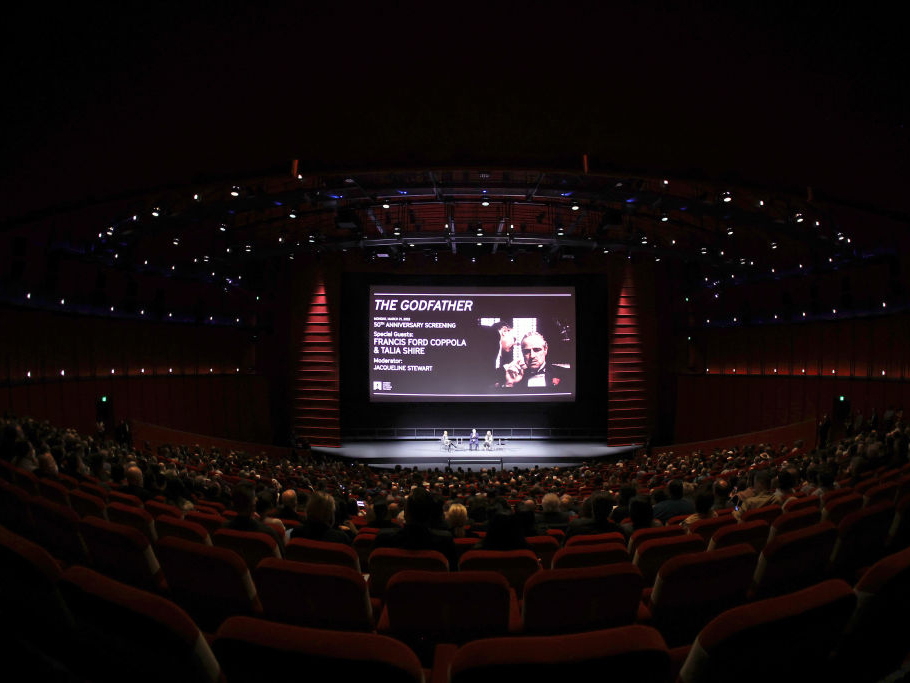
- Industry
An Offer No One Can Refuse – “The Godfather” at 50
UPDATE- The cycle of honors around the 50th Anniversary of The Godfather will close in full regalia this weekend. On Saturday, October 29, at 7:30 PM, Francis Ford Coppola’s classic film, winner of five Golden Globes, will screen for one night only, to the sound of Nino Rota’s score, played live by a 61-piece orchestra at the Dolby Theatre, 6801 Hollywood Blvd. On November 12, there will be a final performance with the Chicago Philharmonic.
Getting back to this historical 50th anniversary, we go back to the opening of the Year of the Godfather.
On this day, in 1972, The Godfather was finally released in the United States. It had been a long journey – the movie had a philanthropy pre-premiere in New York on March 14 (after Paramount had nixed a release on Christmas Day 1971). On March 17 The Godfather arrived in Toronto, Canada, and on March 22, began its run in Los Angeles, in two theaters.
On March 24, 1972, Francis Ford Coppola’s future masterpiece took over the United States, opening everywhere. It arrived on screens already a hit, with $15 million accrued from the first initial 3 launches. At the end of this first run, 50 years ago, The Godfather had beaten Gone with the Wind, then the biggest blockbuster on American screens, amassing $85.7 million (Jaws would knock it down in 1975, but, for a moment, let’s leave it that way). The shower of accolades came after, including 7 Golden Globe nominations and 5 wins.
In honor of this landmark, the Academy Museum of Motion Pictures has turned this week into a Godfather celebration, with a series of screenings of the whole Godfather Trilogy, starting on March 21 with The Godfather, March 23 with The Godfather Part II and closing today with The Godfather Part III in its recut version, The Godfather Coda: The Death of Michael Corleone.
The opening night of the Godfather week was a treat on its own: before the screening of the restored copy – with crystalline sound and all scenes that had been cut in the past – Francis Ford Coppola himself took the stage with his sister and actress Talia Shire, for a conversation with Academy Museum Chief Artistic and Programming Officer Jacqueline Stewart.
They were met with a 5-minute standing ovation from the full house at the David Geffen Theater, Coppola was both emotional and at ease, and jumped right away into the narrative of his life in San Francisco – “I was 29, a father, broke, desperate, with two kids, looking for serious work. And then I had a miraculous day.”
The miraculous day was a phone call and an unexpected visitor. The visit was from producer Albert Ruddy, who definitely wanted Coppola as the director of the movie based on Mario Puzo’s best seller. The call was from Marlon Brando, whom Coppola had always imagined as his Don Corleone, but who, in the recent past, had said no to another Coppola offer. “It was stunning”, he said. “How could that happen? On the same day?!”
It would be a long journey of its own. In 1967 Paramount bought the rights to the book, and Coppola hated “2/3 of the book. 2/3 were crap, pure pulp, there was no story, no heart. 1/3 was interesting – that was the part that I could work with.” Robert Evans, then Paramount’s Head of Production, had been in search of “an Italian-Italian” for the adaptation and arrived on Coppola through the idea of then Vice-President of Production Peter Bart. Their previous efforts with movies about the Italian community had failed – “they had Kirk Douglas as an Italian in a mafia movie!”, Coppola laughed, adding that he himself had to learn a bit more on how to be an Italian.
Halfway deep into the project and research, Coppola got the news that the studio wanted the story moved from 1945 to 1970, in Los Angeles or Las Vegas, to save money on location and wardrobe. “That was my first fight”, he said. “There were many.”
Securing Brando was one. Having rehearsal time was another. Pushing for a “decent budget” was a constant. While all this was happening, Coppola was using the tools he learned while studying theater – “I wanted to learn directing, but the course focused basically on acting. I learned, anyway…” – by creating a ‘prompt copy’, also known as ‘the book’, that stage managers have on hand during rehearsals and plays, helping actors to stay in character. “It was a monster book”, Coppola says. “I made lists and lists on all the aspects of each character”.
Of all the fights and discoveries of the journey to The Godfather, there was a moment that Coppola cherishes. After picking his actors, Coppola began to worry about the chemistry among them, in a story that was so intensely familial. With rehearsal time short, he opted for an unusual solution – he booked a private room in a neighborhood Italian restaurant in New York and invited all his actors: Marlon Brando, Al Pacino, James Caan, and Robert Duvall. Talia Shire had a very important role – she would be the waitress.
And this is what happened – Pacino and Caan immediately got into a conversation about sports; Brando set at the head of the table, looking very serious, at ease; Duvall did Brando impersonations; Shire ran back and forth with the appetizers, a bit stressed, a bit happy, trying to maintain order at the table.
“It was so beautiful, it was magical”, he said, with emotion in his voice. “They became a family, right before my eyes. Then I knew I had a film in my hands.”

